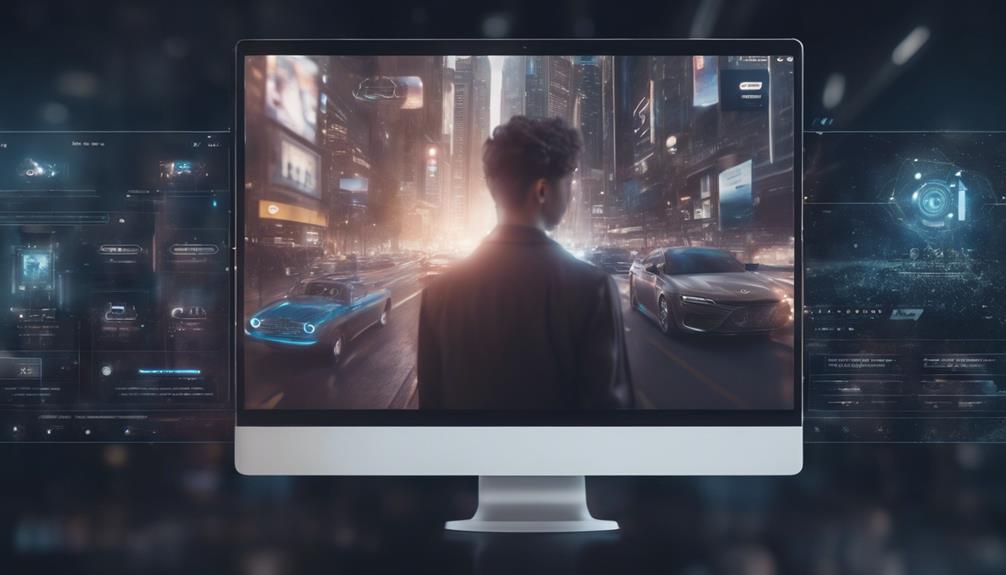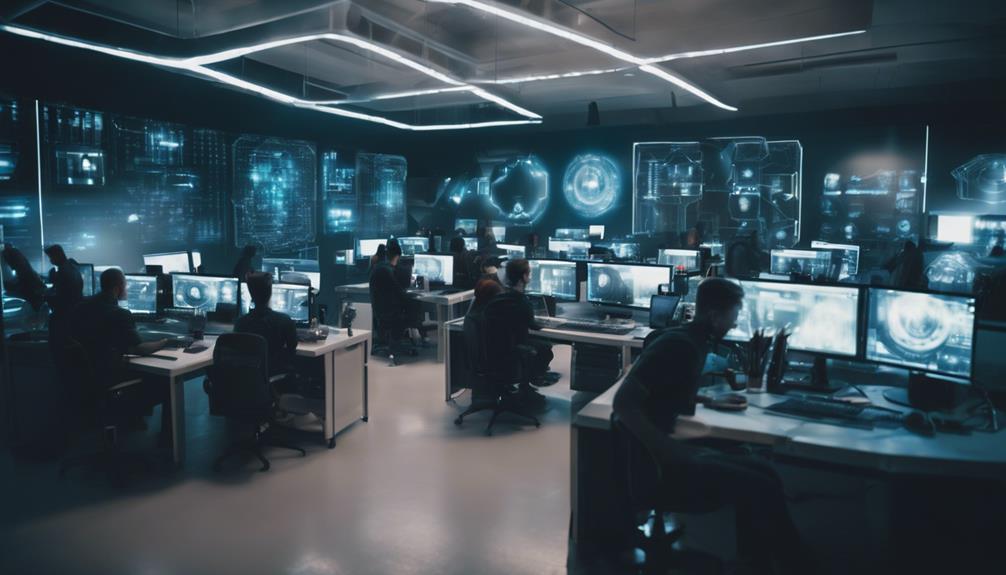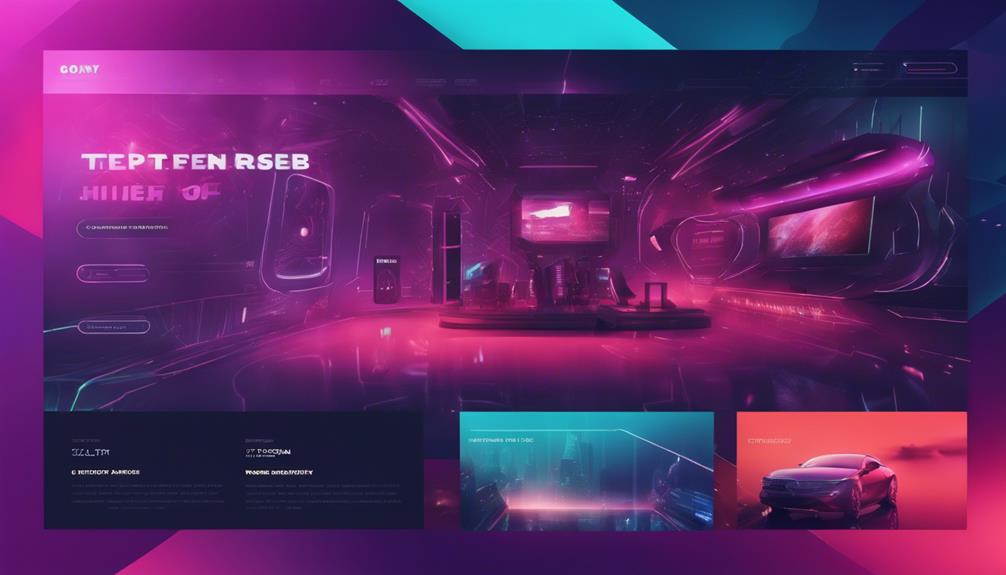In the fast-evolving landscape of web design, staying ahead of the curve is paramount for agencies looking to remain competitive. As we approach 2024, several key trends are poised to shape the industry.
From the integration of advanced AI to the rise of interactive 3D experiences, web design agencies are navigating a complex terrain of innovation and user experience enhancement. However, amidst these developments, a particular trend stands out as a game-changer, promising to redefine the way websites engage with audiences.
This shift towards sustainability in web design not only reflects a growing social consciousness but also underscores the importance of creating digital experiences that resonate with environmentally-conscious users.
Advanced AI Integration

The integration of advanced AI technologies is poised to revolutionize the web design industry in 2024. AI is increasingly being utilized by web design agencies to enhance user experiences, streamline development processes, and personalize content delivery. Through the use of AI web design tools, agencies can automate tasks such as layout creation, content generation, and user interface optimization. This advanced AI integration enables designers to focus more on creativity and strategy while leaving repetitive tasks to intelligent algorithms.
Web design AI algorithms analyze user behavior, preferences, and trends to create tailored website experiences. By leveraging machine learning algorithms, web designers can predict user actions, customize recommendations, and optimize conversions. Additionally, AI-powered chatbots are becoming more sophisticated, providing real-time customer support and enhancing user engagement on websites.
Interactive 3D Experiences
Embracing cutting-edge technology, web design agencies are increasingly incorporating interactive 3D experiences to captivate and engage users in innovative ways. This trend in interactive web design is reshaping the digital landscape, offering users a more immersive and engaging online experience. By leveraging 3D web design, agencies can create visually stunning websites that allow users to interact with content in a more dynamic and personalized manner.
One of the key advantages of incorporating interactive 3D experiences into web design is the ability to showcase products or services in a more realistic and engaging way. This not only enhances user engagement but also helps businesses stand out in a crowded online market. As part of the evolving web design trends, 3D elements provide a unique opportunity for storytelling and brand communication, allowing users to explore content in a more interactive and memorable fashion.
Voice User Interface (VUI) Design

In the realm of web design innovation, Voice User Interface (VUI) Design has emerged as a pivotal element reshaping user interactions and experiences online. VUI design focuses on creating interfaces that allow users to interact with websites through voice commands, enhancing accessibility and user engagement. When implementing VUI design principles, web designers must consider factors such as natural language processing, speech recognition accuracy, and user feedback mechanisms to ensure a seamless user experience.
Integrating VUI into UI web design requires a deep understanding of how users communicate verbally and the context in which these interactions occur. By incorporating VUI design elements, websites can offer users a hands-free and intuitive way to navigate content, conduct searches, and perform various tasks online. This trend aligns with the growing popularity of voice-controlled devices and virtual assistants, making it essential for web designers to adapt to changing user preferences and technological advancements in the digital landscape. As VUI design continues to evolve, mastering this aspect of web design will be crucial for creating immersive and user-friendly online experiences.
Sustainability in Web Design
With the increasing emphasis on user experience and technological advancements in web design, sustainability has emerged as a critical consideration for creating environmentally conscious online platforms. As one of the latest web design trends, sustainability in web design, also known as green web design, focuses on reducing the carbon footprint and promoting eco-friendly practices in website development. This trend emphasizes using renewable energy sources, optimizing website performance to reduce energy consumption, and implementing design elements that support environmental conservation.
Green web design involves utilizing efficient coding practices, optimizing images and videos for faster loading times, and reducing server requests to minimize energy usage. Designers are also incorporating sustainable features like dark mode options to reduce screen brightness and save energy on devices. By integrating sustainability principles into web design, businesses can demonstrate their commitment to environmental responsibility while providing users with a more eco-conscious online experience. As this trend continues to gain traction, we can expect to see more websites prioritizing sustainability and implementing innovative green design solutions.
Data Privacy and Security Focus

As web design agencies navigate the evolving digital landscape, an increasing emphasis is placed on ensuring data privacy and security within online platforms. With cyber threats on the rise, web design agencies are prioritizing security measures to protect user data and maintain the trust of their clients. Implementing robust security protocols has become a fundamental aspect of web design agency practices to safeguard against data breaches, unauthorized access, and other malicious activities.
Web design agencies are incorporating encryption technologies, secure hosting services, and regular security audits to fortify their clients' websites against potential vulnerabilities. By staying informed about the latest security threats and compliance regulations, these agencies can proactively address security concerns and prevent data leaks. Moreover, educating clients about best practices for data privacy and security is becoming standard procedure for web design agencies to empower users in safeguarding their information.
Augmented Reality (AR) Integration
The integration of Augmented Reality (AR) technology into web design practices is revolutionizing user experiences and enhancing engagement on digital platforms. Web design agencies are increasingly incorporating AR to create immersive and interactive websites that captivate visitors. By blending the virtual world with the real environment, AR integration allows users to engage with products or services in a more personalized and dynamic way. Creative web design agencies are leveraging AR to showcase products in 3D, offer virtual tours of spaces, or provide interactive experiences that were previously impossible with traditional web design techniques.
Through augmented reality integration, web design agencies can differentiate their services, offering clients innovative solutions that set their websites apart from competitors. This trend not only enhances user engagement but also boosts brand perception and loyalty. As AR technology continues to advance, its seamless integration into web design practices will likely become a standard feature for creating cutting-edge digital experiences.
Frequently Asked Questions
How Can Web Design Agencies Effectively Balance Advanced AI Integration With MAIntAIning a Personal Touch in User Experiences?
To effectively balance advanced AI integration with maintaining a personal touch in user experiences, web design agencies should focus on leveraging AI for efficiency while ensuring personalized interactions through thoughtful design elements and human-centered approaches.
What Are Some Common Challenges Faced When Implementing Interactive 3D Experiences on Websites, and How Can They Be Overcome?
Implementing interactive 3D experiences on websites presents challenges like performance issues, compatibility across devices, and user experience optimization. Overcoming these hurdles requires meticulous planning, utilizing efficient coding techniques, and prioritizing seamless functionality for all users.
How Can Web Designers Ensure That Voice User Interface (Vui) Design Is Inclusive and Accessible to All Users, Including Those With Disabilities?
Web designers can ensure inclusive and accessible Voice User Interface (VUI) design by prioritizing clear and concise language, providing alternative input methods, testing with diverse user groups, and following accessibility guidelines like WCAG for a more inclusive user experience.
What Are Some Practical Ways That Web Design Agencies Can Incorporate Sustainability Practices Into Their Design Processes?
Incorporating sustainability practices into web design processes involves utilizing eco-friendly hosting, optimizing site performance for energy efficiency, reducing digital waste through efficient coding practices, and advocating for accessible and inclusive design principles to create a more environmentally conscious web ecosystem.
What Measures Can Be Taken to Ensure Data Privacy and Security Are Prioritized in Web Design Projects, Especially With the Increasing Concerns Around Data Breaches and Cyber Threats?
To prioritize data privacy and security in web design projects amidst rising concerns of data breaches and cyber threats, measures include implementing encryption protocols, regular security audits, user data protection policies, and staff training on best practices for handling sensitive information.

